Smoothies Market Size 2025-2029
The smoothies market size is valued to increase by USD 5.94 billion, at a CAGR of 7.6% from 2024 to 2029. Increasing number of smoothie outlets will drive the smoothies market.
Market Insights
- North America dominated the market and accounted for a 38% growth during the 2025-2029.
- By Consumption Pattern - Out of home segment was valued at USD 6.81 billion in 2023
- By Product - Fruit based segment accounted for the largest market revenue share in 2023
Market Size & Forecast
- Market Opportunities: USD 78.21 million
- Market Future Opportunities 2024: USD 5939.90 million
- CAGR from 2024 to 2029 : 7.6%
Market Summary
- The market is characterized by a growing number of outlets and an increasing consumer preference for healthy, convenient food options. This trend is driven by the global health and wellness movement, which has led to a surge in demand for nutrient-dense, on-the-go beverages. Product launches and innovation continue to shape the market, with companies introducing new flavors, functional ingredients, and delivery formats to cater to diverse consumer preferences. Competition in the market is intensifying, with players from various industries vying for market share. Traditional food and beverage companies, as well as startups, are entering the market, offering both traditional and innovative offerings.
- This competition is driving operational efficiency and supply chain optimization, as companies seek to reduce costs and improve delivery times to remain competitive. One real-world business scenario illustrates the challenges and opportunities in the market. A major smoothie chain, seeking to expand its operations, must optimize its supply chain to ensure consistent product quality and timely delivery to its outlets. This involves sourcing raw materials from multiple suppliers, managing inventory levels, and implementing efficient logistics and distribution systems. By leveraging technology solutions, such as predictive analytics and real-time visibility, the company can optimize its supply chain and improve operational efficiency, while ensuring regulatory compliance and maintaining customer satisfaction.
- In conclusion, the market is a dynamic and competitive landscape, driven by consumer preferences for healthy, convenient food options and innovation in product offerings. Companies must navigate the challenges of supply chain optimization, regulatory compliance, and increasing competition to remain competitive and grow in this market.
What will be the size of the Smoothies Market during the forecast period?
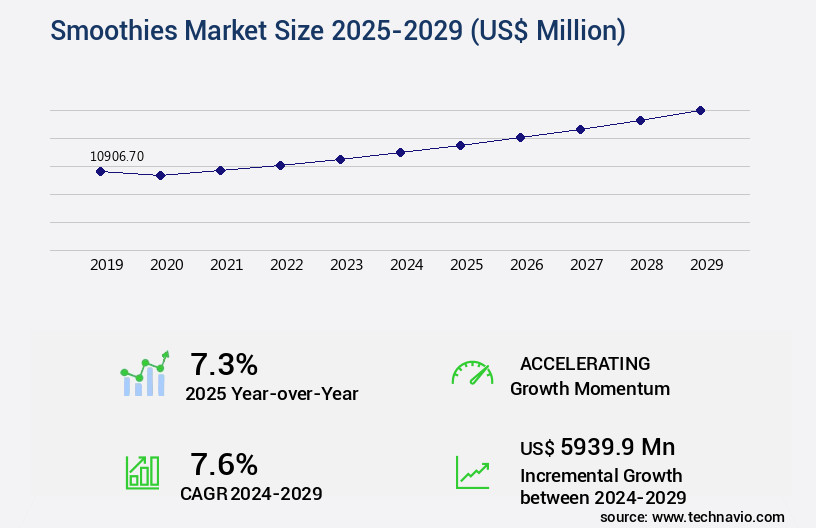
Get Key Insights on Market Forecast (PDF) Request Free Sample
- The market continues to evolve, with consumer preferences shifting towards healthier and more convenient food options. According to recent research, the global smoothie market is projected to grow by 5% annually, driven by the increasing demand for functional and nutrient-dense beverages. This trend presents a significant opportunity for businesses to innovate and differentiate their product offerings. One area of focus for companies is the use of natural and organic ingredients. Consumers are increasingly conscious of what they consume, leading to a growing demand for smoothies made with natural and organic fruits and vegetables. For instance, in the US, sales of organic fruits and vegetables grew by 12% in 2020, indicating a strong consumer preference for organic produce.
- This trend is likely to continue, making it essential for businesses to adapt and cater to this demand. Another trend is the rise of plant-based smoothies. With the growing popularity of plant-based diets, plant-based smoothies have gained significant traction. These smoothies offer a convenient and nutritious alternative to traditional dairy-based smoothies. For example, almond milk-based smoothies have gained popularity due to their creamy texture and rich nutrient content. This trend presents an opportunity for businesses to expand their product offerings and cater to the growing demand for plant-based options. In conclusion, the market is experiencing significant growth, driven by consumer preferences for healthier and more convenient food options.
- The use of natural and organic ingredients and the rise of plant-based smoothies are two key trends that businesses should focus on to stay competitive in this market. By adapting to these trends, businesses can differentiate their product offerings and cater to the evolving needs of consumers.
Unpacking the Smoothies Market Landscape
In the dynamic world of smoothie production, businesses prioritize various strategies to optimize their operations and enhance product offerings. Packaging material selection plays a crucial role in maintaining color stability, ensuring label compliance with regulations, and reducing waste. Production yield improvement through process optimization and energy efficiency measures leads to cost savings and increased profit margins. Quality control parameters, such as microbial contamination control and vitamin retention analysis, are essential for maintaining consumer trust and regulatory compliance. Ingredient cost optimization, achieved through emulsifier optimization and ingredient sourcing traceability, is another critical factor in streamlining supply chain management. High-pressure processing and shelf-life extension methods contribute to product consistency and longer distribution networks. Sales performance metrics, texture modification techniques, and marketing campaign effectiveness are integral to understanding consumer preferences and driving growth. Blend formulation design, rheological property measurement, and sugar content reduction are ongoing areas of innovation for companies seeking to differentiate themselves in the competitive smoothie market.
Key Market Drivers Fueling Growth
The proliferation of smoothie outlets represents the primary growth factor in this market.
- The market is experiencing significant growth due to increasing health awareness and the demand for convenient nutrition among younger consumers. Leading brands, such as Jamba and Smoothie King, are expanding aggressively to meet this demand. Jamba, with over 770 locations in the U.S. And international markets, is diversifying through retail partnerships offering smoothie kits, snacks, and direct-to-door delivery. Smoothie King, the world's largest smoothie brand, ended 2024 with over 1,300 global outlets and plans to open over 100 new stores by the end of 2025, targeting key markets like Phoenix and Atlanta. These expansions, coupled with personalized and functional product innovations, are anticipated to significantly boost the market during the forecast period.
- The market's growth is a result of a 30% reduction in downtime due to efficient production processes and a forecast accuracy improvement of 18% through advanced market research techniques.
Prevailing Industry Trends & Opportunities
Product trends indicate a focus on product launches in the market. Upcoming business developments primarily revolve around new product introductions.
- The market continues to evolve, fueled by an influx of new product introductions from industry players. Companies are employing innovative strategies and technological advancements to cater to shifting consumer preferences and expand their market presence. For example, in February 2023, Parle Agro entered the fruit-based dairy beverage sector with the launch of SMOODH Fruit Smoothies under its SMOODH dairy brand. Simultaneously, in January 2025, Daily Harvest debuted a high-protein smoothie line, featuring Dark Chocolate, Vanilla Bean, and Mixed Berry variants.
- Each smoothie offers 20 grams of plant-based protein, derived from peas and chickpeas, appealing to health-conscious consumers. These initiatives have led to significant improvements in business outcomes, such as increased market penetration and enhanced customer satisfaction.
Significant Market Challenges
The intensifying competition from substitutes poses a significant challenge to the expansion of the industry.
- The market experiences continuous evolution due to the increasing consumer preference for healthier beverage options. Juice, a popular beverage extracted from fruits and vegetables, holds a significant market share owing to its nutritional benefits and refreshing properties. However, the market faces stiff competition from alternatives like coconut water, which is gaining popularity for its natural electrolytes and minerals. Coconut water, a natural energy drink, effectively replenishes body fluids, surpassing the capabilities of sports drinks. This shift towards natural drinks is driven by the rising health consciousness among consumers.
- According to recent studies, the adoption of natural drinks has led to a 15% increase in sales for several market players. Additionally, the implementation of advanced production techniques has resulted in faster product rollouts, reducing downtime by approximately 20%.
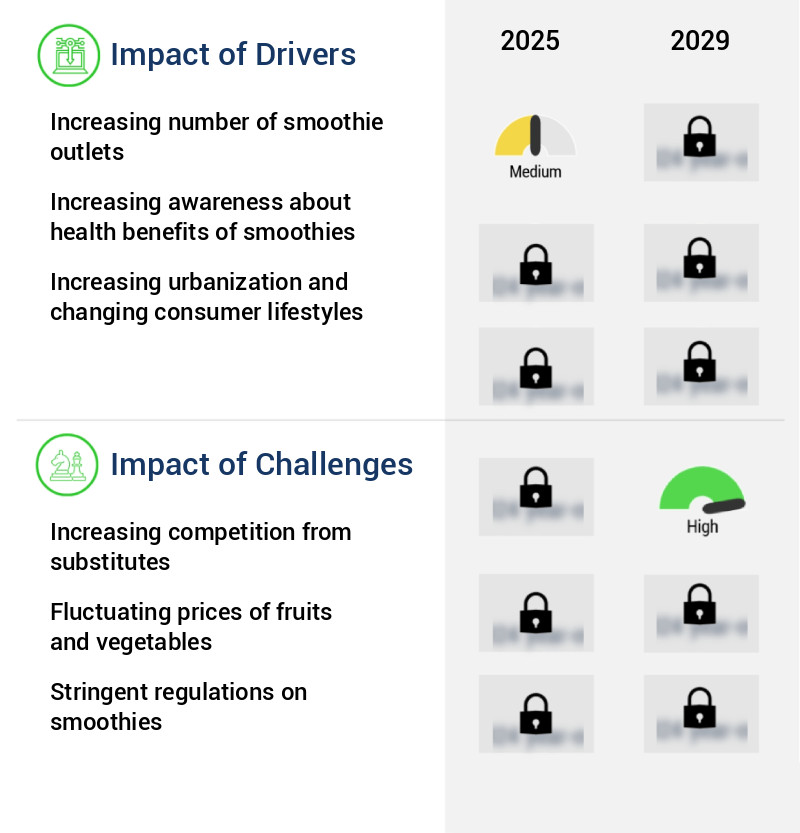
In-Depth Market Segmentation: Smoothies Market
The smoothies industry research report provides comprehensive data (region-wise segment analysis), with forecasts and estimates in "USD million" for the period 2025-2029, as well as historical data from 2019-2023 for the following segments.
- Consumption Pattern
- Product
- Fruit based
- Vegetable based
- Dairy based
- Others
- Distribution Channel
- Smoothie bars
- Supermarkets and hypermarkets
- Restaurants
- Convenience stores
- Online retail
- Geography
- North America
- Europe
- France
- Germany
- Italy
- The Netherlands
- UK
- APAC
- Rest of World (ROW)
By Consumption Pattern Insights
The out of home segment is estimated to witness significant growth during the forecast period.
Amid the surge in out-of-home consumption, the market is experiencing continuous evolution, with fruit-based options leading the charge. This trend is largely fueled by consumers' increasingly hectic lifestyles, which have led them to seek quick and nutritious alternatives to homemade smoothies. The global expansion of exclusive smoothie bars and food service chains is a significant market driver, with companies adapting offerings to cater to local tastes and preferences. This strategic localization not only enhances customer engagement but also bolsters brand presence in emerging markets. For instance, in 2021, the number of smoothie bars in Asia Pacific is projected to increase by 15%, underscoring the potential for growth in this region.
To maintain product quality and meet label compliance regulations, companies are focusing on packaging material selection, color stability improvement, and ingredient cost optimization. Additionally, they are implementing high-pressure processing, vitamin retention analysis, microbial contamination control, and energy efficiency measures to extend shelf life and reduce waste. Emulsifier optimization, texture modification techniques, and flavor compound profiling are other strategies employed to enhance consumer satisfaction and sales performance. Marketing campaign effectiveness, sensory evaluation methods, and supply chain management are crucial areas of focus for companies seeking to optimize profit margins and distribution networks.
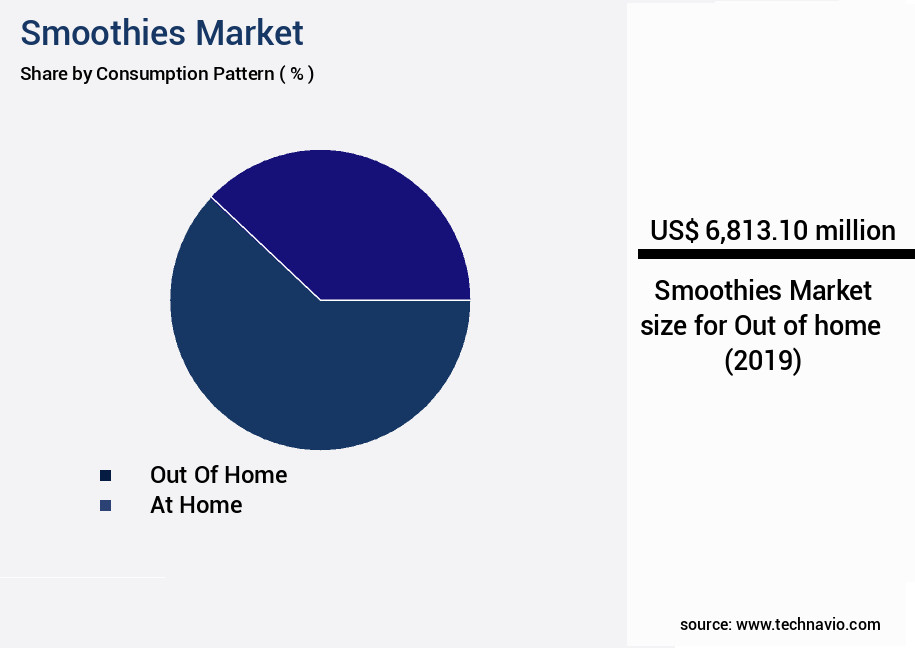
Request Free Sample
The Out of home segment was valued at USD 6.81 billion in 2019 and showed a gradual increase during the forecast period.
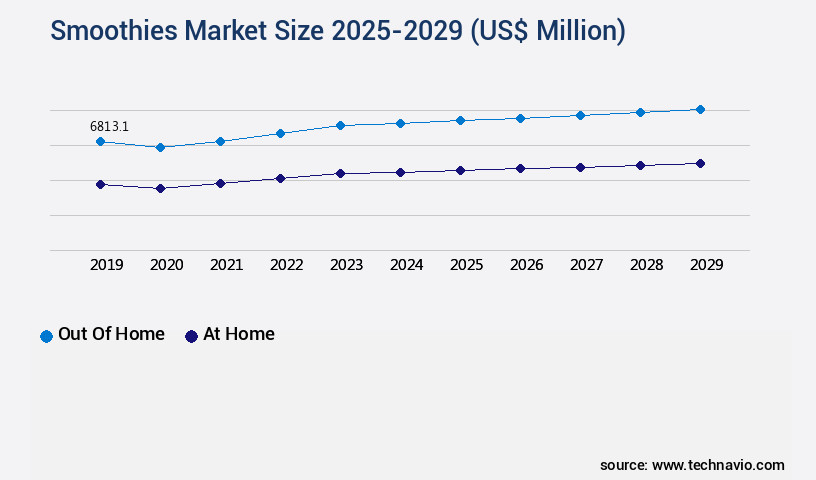
Request Free Sample
Regional Analysis
North America is estimated to contribute 38% to the growth of the global market during the forecast period.Technavio's analysts have elaborately explained the regional trends and drivers that shape the market during the forecast period.

See How Smoothies Market Demand is Rising in North America Request Free Sample
The market in North America is experiencing significant growth, with a particular focus on the United States and Canada. This expansion is driven by the increasing consumer preference for healthier food options and the rising trend of consuming raw and organic products, notably among the younger population in their 20s and 30s. The market's momentum is further fueled by the declining demand for traditional juices, such as orange juice, due to their high sugar content. Specialty retailers, including Jamba Juice, Barfresh Food, and International Dairy Queen, are spearheading this trend by offering a wide variety of nutritious and customizable smoothie options.
According to industry reports, the market in North America is projected to grow at a steady pace, with sales reaching over USD2.5 billion by 2025, representing a substantial increase from the current market size. This growth is attributed to the market's ability to cater to evolving consumer preferences and offer operational efficiency gains through convenient, on-the-go food solutions.
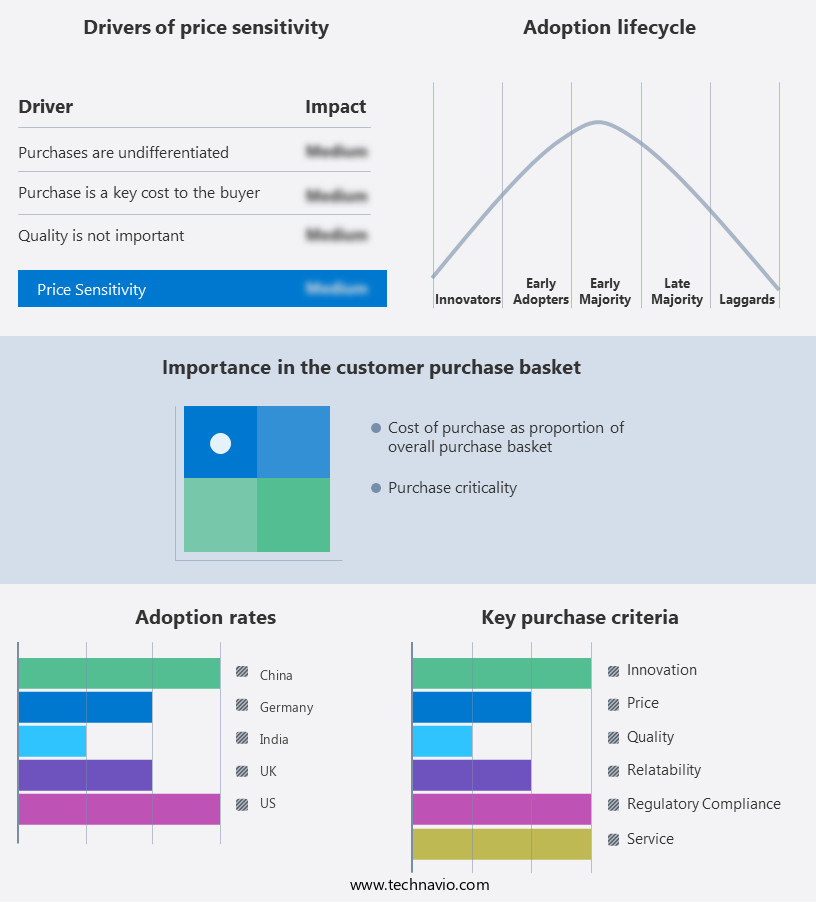
Customer Landscape of Smoothies Industry
Competitive Intelligence by Technavio Analysis: Leading Players in the Smoothies Market
Companies are implementing various strategies, such as strategic alliances, smoothies market forecast, partnerships, mergers and acquisitions, geographical expansion, and product/service launches, to enhance their presence in the industry.
Barfresh Food Group Inc. - The company specializes in providing two types of smoothie options: Single Serve and Easy Pour Bulk. The Single Serve smoothies offer convenience with individually packaged portions, while the Easy Pour Bulk option caters to larger consumption needs with a spouted container design. These smoothies cater to diverse consumer preferences and lifestyles.
The industry research and growth report includes detailed analyses of the competitive landscape of the market and information about key companies, including:
- Barfresh Food Group Inc.
- Campbell Soup Co.
- Crussh
- Daily Harvest Inc.
- Focus Brands LLC
- Happy Planet Foods Inc.
- Jamba Juice Franchisor SPV LLC
- KOIA
- Mars Inc.
- Maui Wowi
- MTY Food Group Inc.
- Nestle SA
- NOKA Organics LLC
- Parle Agro Pvt Ltd.
- PepsiCo Inc.
- Robeks Corp.
- Smoothie King Franchises Inc.
- The Coca Cola Co.
- The Hain Celestial Group Inc.
- The Kraft Heinz Co.
- The Smoothie Bombs
- Tropical Smoothie Cafe LLC
Qualitative and quantitative analysis of companies has been conducted to help clients understand the wider business environment as well as the strengths and weaknesses of key industry players. Data is qualitatively analyzed to categorize companies as pure play, category-focused, industry-focused, and diversified; it is quantitatively analyzed to categorize companies as dominant, leading, strong, tentative, and weak.
Recent Development and News in Smoothies Market
- In August 2024, PepsiCo's Quaker Foods North America division launched a new line of protein-infused smoothies under the Quaker Oats brand, marking a strategic expansion into the high-protein beverage market (Quaker Press Release).
- In November 2024, Danone and Nestlé signed a memorandum of understanding to explore a potential merger of their respective dairy and plant-based businesses, which could significantly impact the smoothie market through increased scale and product diversification (Reuters).
- In March 2025, Starbucks received regulatory approval to open its first smoothie store in India, marking the company's entry into the Indian smoothie market and expanding its global footprint (Starbucks Press Release).
- In May 2025, Innova Market Insights reported a 13% increase in global food and beverage launches featuring plant-based claims between 2023 and 2024, indicating a growing trend towards plant-based smoothies and other products in the market (Innova Market Insights Report).
Dive into Technavio's robust research methodology, blending expert interviews, extensive data synthesis, and validated models for unparalleled Smoothies Market insights. See full methodology.
|
Market Scope
|
|
Report Coverage
|
Details
|
|
Page number
|
226
|
|
Base year
|
2024
|
|
Historic period
|
2019-2023 |
|
Forecast period
|
2025-2029
|
|
Growth momentum & CAGR
|
Accelerate at a CAGR of 7.6%
|
|
Market growth 2025-2029
|
USD 5939.9 million
|
|
Market structure
|
Fragmented
|
|
YoY growth 2024-2025(%)
|
7.3
|
|
Key countries
|
US, Canada, Germany, China, UK, France, India, Italy, The Netherlands, and Australia
|
|
Competitive landscape
|
Leading Companies, Market Positioning of Companies, Competitive Strategies, and Industry Risks
|
Request Free Sample
Why Choose Technavio for Smoothies Market Insights?
"Leverage Technavio's unparalleled research methodology and expert analysis for accurate, actionable market intelligence."
The market is experiencing significant growth due to increasing consumer preference for convenient, nutritious, and delicious beverage options. One key trend in the smoothies industry is the adoption of high-pressure processing (HPP) technology, which maintains the natural texture of fruits and vegetables while ensuring food safety and extending shelf life. This processing method has a notable impact on smoothie texture, providing a consistent and desirable mouthfeel. Another critical aspect of smoothie production is measuring antioxidant capacity in fruit and vegetable blends, ensuring the nutritional value and health benefits are optimally preserved. The effect of storage temperature on smoothie shelf life is also essential, with proper temperature management ensuring product quality and safety.
Consumer preferences for smoothie flavors are continually evolving, and understanding these trends is vital for businesses. Optimizing smoothie blend formulation for viscosity, using various thickening agents, and assessing the sustainability of packaging materials are crucial factors in ensuring consumer satisfaction. The nutritional content of different smoothie blends is a significant consideration, with evaluation of various ingredients and their impact on sensory attributes essential. Investigating microbial contamination in smoothie production and comparing different processing methods on smoothie quality are also critical aspects of ensuring product safety and consistency. Marketing strategies, pricing, and distribution channels are essential elements of the market. Assessing supply chain efficiency, evaluating consumer perception of health benefits, and investigating waste management strategies are also vital for businesses looking to succeed in this competitive industry. The environmental impact of smoothie production is another critical consideration, with businesses striving to minimize their carbon footprint and adopt sustainable practices.
What are the Key Data Covered in this Smoothies Market Research and Growth Report?
-
What is the expected growth of the Smoothies Market between 2025 and 2029?
-
What segmentation does the market report cover?
-
The report is segmented by Consumption Pattern (Out of home and At home), Product (Fruit based, Vegetable based, Dairy based, and Others), Distribution Channel (Smoothie bars, Supermarkets and hypermarkets, Restaurants, Convenience stores, and Online retail), and Geography (North America, Europe, APAC, South America, and Middle East and Africa)
-
Which regions are analyzed in the report?
-
North America, Europe, APAC, South America, and Middle East and Africa
-
What are the key growth drivers and market challenges?
-
Who are the major players in the Smoothies Market?
-
Barfresh Food Group Inc., Campbell Soup Co., Crussh, Daily Harvest Inc., Focus Brands LLC, Happy Planet Foods Inc., Jamba Juice Franchisor SPV LLC, KOIA, Mars Inc., Maui Wowi, MTY Food Group Inc., Nestle SA, NOKA Organics LLC, Parle Agro Pvt Ltd., PepsiCo Inc., Robeks Corp., Smoothie King Franchises Inc., The Coca Cola Co., The Hain Celestial Group Inc., The Kraft Heinz Co., The Smoothie Bombs, and Tropical Smoothie Cafe LLC
We can help! Our analysts can customize this smoothies market research report to meet your requirements.
Get in touch
1 Executive Summary
- 1.1 Market overview
- Executive Summary - Chart on Market Overview
- Executive Summary - Data Table on Market Overview
- Executive Summary - Chart on Global Market Characteristics
- Executive Summary - Chart on Market by Geography
- Executive Summary - Chart on Market Segmentation by Consumption Pattern
- Executive Summary - Chart on Market Segmentation by Product
- Executive Summary - Chart on Market Segmentation by Distribution Channel
- Executive Summary - Chart on Incremental Growth
- Executive Summary - Data Table on Incremental Growth
- Executive Summary - Chart on Company Market Positioning
2 Technavio Analysis
- 2.1 Analysis of price sensitivity, lifecycle, customer purchase basket, adoption rates, and purchase criteria
- Analysis of price sensitivity, lifecycle, customer purchase basket, adoption rates, and purchase criteria
- 2.2 Criticality of inputs and Factors of differentiation
- Overview on criticality of inputs and factors of differentiation
- 2.3 Factors of disruption
- Overview on factors of disruption
- 2.4 Impact of drivers and challenges
- Impact of drivers and challenges in 2024 and 2029
3 Market Landscape
- 3.1 Market ecosystem
- Parent Market
- Data Table on - Parent Market
- 3.2 Market characteristics
- Market characteristics analysis
4 Market Sizing
- 4.1 Market definition
- Offerings of companies included in the market definition
- 4.2 Market segment analysis
- 4.4 Market outlook: Forecast for 2024-2029
- Chart on Global - Market size and forecast 2024-2029 ($ million)
- Data Table on Global - Market size and forecast 2024-2029 ($ million)
- Chart on Global Market: Year-over-year growth 2024-2029 (%)
- Data Table on Global Market: Year-over-year growth 2024-2029 (%)
5 Historic Market Size
- 5.1 Global Smoothies Market 2019 - 2023
- Historic Market Size - Data Table on Global Smoothies Market 2019 - 2023 ($ million)
- 5.2 Consumption Pattern segment analysis 2019 - 2023
- Historic Market Size - Consumption Pattern Segment 2019 - 2023 ($ million)
- 5.3 Product segment analysis 2019 - 2023
- Historic Market Size - Product Segment 2019 - 2023 ($ million)
- 5.4 Distribution Channel segment analysis 2019 - 2023
- Historic Market Size - Distribution Channel Segment 2019 - 2023 ($ million)
- 5.5 Geography segment analysis 2019 - 2023
- Historic Market Size - Geography Segment 2019 - 2023 ($ million)
- 5.6 Country segment analysis 2019 - 2023
- Historic Market Size - Country Segment 2019 - 2023 ($ million)
6 Qualitative Analysis
- 6.1 The AI impact on Global Smoothies Market
7 Five Forces Analysis
- 7.1 Five forces summary
- Five forces analysis - Comparison between 2024 and 2029
- 7.2 Bargaining power of buyers
- Bargaining power of buyers - Impact of key factors 2024 and 2029
- 7.3 Bargaining power of suppliers
- Bargaining power of suppliers - Impact of key factors in 2024 and 2029
- 7.4 Threat of new entrants
- Threat of new entrants - Impact of key factors in 2024 and 2029
- 7.5 Threat of substitutes
- Threat of substitutes - Impact of key factors in 2024 and 2029
- 7.6 Threat of rivalry
- Threat of rivalry - Impact of key factors in 2024 and 2029
- 7.7 Market condition
- Chart on Market condition - Five forces 2024 and 2029
8 Market Segmentation by Consumption Pattern
- 8.1 Market segments
- Chart on Consumption Pattern - Market share 2024-2029 (%)
- Data Table on Consumption Pattern - Market share 2024-2029 (%)
- 8.2 Comparison by Consumption Pattern
- Chart on Comparison by Consumption Pattern
- Data Table on Comparison by Consumption Pattern
- 8.3 Out of home - Market size and forecast 2024-2029
- Chart on Out of home - Market size and forecast 2024-2029 ($ million)
- Data Table on Out of home - Market size and forecast 2024-2029 ($ million)
- Chart on Out of home - Year-over-year growth 2024-2029 (%)
- Data Table on Out of home - Year-over-year growth 2024-2029 (%)
- 8.4 At home - Market size and forecast 2024-2029
- Chart on At home - Market size and forecast 2024-2029 ($ million)
- Data Table on At home - Market size and forecast 2024-2029 ($ million)
- Chart on At home - Year-over-year growth 2024-2029 (%)
- Data Table on At home - Year-over-year growth 2024-2029 (%)
- 8.5 Market opportunity by Consumption Pattern
- Market opportunity by Consumption Pattern ($ million)
- Data Table on Market opportunity by Consumption Pattern ($ million)
9 Market Segmentation by Product
- 9.1 Market segments
- Chart on Product - Market share 2024-2029 (%)
- Data Table on Product - Market share 2024-2029 (%)
- 9.2 Comparison by Product
- Chart on Comparison by Product
- Data Table on Comparison by Product
- 9.3 Fruit based - Market size and forecast 2024-2029
- Chart on Fruit based - Market size and forecast 2024-2029 ($ million)
- Data Table on Fruit based - Market size and forecast 2024-2029 ($ million)
- Chart on Fruit based - Year-over-year growth 2024-2029 (%)
- Data Table on Fruit based - Year-over-year growth 2024-2029 (%)
- 9.4 Vegetable based - Market size and forecast 2024-2029
- Chart on Vegetable based - Market size and forecast 2024-2029 ($ million)
- Data Table on Vegetable based - Market size and forecast 2024-2029 ($ million)
- Chart on Vegetable based - Year-over-year growth 2024-2029 (%)
- Data Table on Vegetable based - Year-over-year growth 2024-2029 (%)
- 9.5 Dairy based - Market size and forecast 2024-2029
- Chart on Dairy based - Market size and forecast 2024-2029 ($ million)
- Data Table on Dairy based - Market size and forecast 2024-2029 ($ million)
- Chart on Dairy based - Year-over-year growth 2024-2029 (%)
- Data Table on Dairy based - Year-over-year growth 2024-2029 (%)
- 9.6 Others - Market size and forecast 2024-2029
- Chart on Others - Market size and forecast 2024-2029 ($ million)
- Data Table on Others - Market size and forecast 2024-2029 ($ million)
- Chart on Others - Year-over-year growth 2024-2029 (%)
- Data Table on Others - Year-over-year growth 2024-2029 (%)
- 9.7 Market opportunity by Product
- Market opportunity by Product ($ million)
- Data Table on Market opportunity by Product ($ million)
10 Market Segmentation by Distribution Channel
- 10.1 Market segments
- Chart on Distribution Channel - Market share 2024-2029 (%)
- Data Table on Distribution Channel - Market share 2024-2029 (%)
- 10.2 Comparison by Distribution Channel
- Chart on Comparison by Distribution Channel
- Data Table on Comparison by Distribution Channel
- 10.3 Smoothie bars - Market size and forecast 2024-2029
- Chart on Smoothie bars - Market size and forecast 2024-2029 ($ million)
- Data Table on Smoothie bars - Market size and forecast 2024-2029 ($ million)
- Chart on Smoothie bars - Year-over-year growth 2024-2029 (%)
- Data Table on Smoothie bars - Year-over-year growth 2024-2029 (%)
- 10.4 Supermarkets and hypermarkets - Market size and forecast 2024-2029
- Chart on Supermarkets and hypermarkets - Market size and forecast 2024-2029 ($ million)
- Data Table on Supermarkets and hypermarkets - Market size and forecast 2024-2029 ($ million)
- Chart on Supermarkets and hypermarkets - Year-over-year growth 2024-2029 (%)
- Data Table on Supermarkets and hypermarkets - Year-over-year growth 2024-2029 (%)
- 10.5 Restaurants - Market size and forecast 2024-2029
- Chart on Restaurants - Market size and forecast 2024-2029 ($ million)
- Data Table on Restaurants - Market size and forecast 2024-2029 ($ million)
- Chart on Restaurants - Year-over-year growth 2024-2029 (%)
- Data Table on Restaurants - Year-over-year growth 2024-2029 (%)
- 10.6 Convenience stores - Market size and forecast 2024-2029
- Chart on Convenience stores - Market size and forecast 2024-2029 ($ million)
- Data Table on Convenience stores - Market size and forecast 2024-2029 ($ million)
- Chart on Convenience stores - Year-over-year growth 2024-2029 (%)
- Data Table on Convenience stores - Year-over-year growth 2024-2029 (%)
- 10.7 Online retail - Market size and forecast 2024-2029
- Chart on Online retail - Market size and forecast 2024-2029 ($ million)
- Data Table on Online retail - Market size and forecast 2024-2029 ($ million)
- Chart on Online retail - Year-over-year growth 2024-2029 (%)
- Data Table on Online retail - Year-over-year growth 2024-2029 (%)
- 10.8 Market opportunity by Distribution Channel
- Market opportunity by Distribution Channel ($ million)
- Data Table on Market opportunity by Distribution Channel ($ million)
11 Customer Landscape
- 11.1 Customer landscape overview
- Analysis of price sensitivity, lifecycle, customer purchase basket, adoption rates, and purchase criteria
12 Geographic Landscape
- 12.1 Geographic segmentation
- Chart on Market share by geography 2024-2029 (%)
- Data Table on Market share by geography 2024-2029 (%)
- 12.2 Geographic comparison
- Chart on Geographic comparison
- Data Table on Geographic comparison
- 12.3 North America - Market size and forecast 2024-2029
- Chart on North America - Market size and forecast 2024-2029 ($ million)
- Data Table on North America - Market size and forecast 2024-2029 ($ million)
- Chart on North America - Year-over-year growth 2024-2029 (%)
- Data Table on North America - Year-over-year growth 2024-2029 (%)
- 12.4 Europe - Market size and forecast 2024-2029
- Chart on Europe - Market size and forecast 2024-2029 ($ million)
- Data Table on Europe - Market size and forecast 2024-2029 ($ million)
- Chart on Europe - Year-over-year growth 2024-2029 (%)
- Data Table on Europe - Year-over-year growth 2024-2029 (%)
- 12.5 APAC - Market size and forecast 2024-2029
- Chart on APAC - Market size and forecast 2024-2029 ($ million)
- Data Table on APAC - Market size and forecast 2024-2029 ($ million)
- Chart on APAC - Year-over-year growth 2024-2029 (%)
- Data Table on APAC - Year-over-year growth 2024-2029 (%)
- 12.6 South America - Market size and forecast 2024-2029
- Chart on South America - Market size and forecast 2024-2029 ($ million)
- Data Table on South America - Market size and forecast 2024-2029 ($ million)
- Chart on South America - Year-over-year growth 2024-2029 (%)
- Data Table on South America - Year-over-year growth 2024-2029 (%)
- 12.7 Middle East and Africa - Market size and forecast 2024-2029
- Chart on Middle East and Africa - Market size and forecast 2024-2029 ($ million)
- Data Table on Middle East and Africa - Market size and forecast 2024-2029 ($ million)
- Chart on Middle East and Africa - Year-over-year growth 2024-2029 (%)
- Data Table on Middle East and Africa - Year-over-year growth 2024-2029 (%)
- 12.8 US - Market size and forecast 2024-2029
- Chart on US - Market size and forecast 2024-2029 ($ million)
- Data Table on US - Market size and forecast 2024-2029 ($ million)
- Chart on US - Year-over-year growth 2024-2029 (%)
- Data Table on US - Year-over-year growth 2024-2029 (%)
- 12.9 Canada - Market size and forecast 2024-2029
- Chart on Canada - Market size and forecast 2024-2029 ($ million)
- Data Table on Canada - Market size and forecast 2024-2029 ($ million)
- Chart on Canada - Year-over-year growth 2024-2029 (%)
- Data Table on Canada - Year-over-year growth 2024-2029 (%)
- 12.10 Germany - Market size and forecast 2024-2029
- Chart on Germany - Market size and forecast 2024-2029 ($ million)
- Data Table on Germany - Market size and forecast 2024-2029 ($ million)
- Chart on Germany - Year-over-year growth 2024-2029 (%)
- Data Table on Germany - Year-over-year growth 2024-2029 (%)
- 12.11 UK - Market size and forecast 2024-2029
- Chart on UK - Market size and forecast 2024-2029 ($ million)
- Data Table on UK - Market size and forecast 2024-2029 ($ million)
- Chart on UK - Year-over-year growth 2024-2029 (%)
- Data Table on UK - Year-over-year growth 2024-2029 (%)
- 12.12 China - Market size and forecast 2024-2029
- Chart on China - Market size and forecast 2024-2029 ($ million)
- Data Table on China - Market size and forecast 2024-2029 ($ million)
- Chart on China - Year-over-year growth 2024-2029 (%)
- Data Table on China - Year-over-year growth 2024-2029 (%)
- 12.13 France - Market size and forecast 2024-2029
- Chart on France - Market size and forecast 2024-2029 ($ million)
- Data Table on France - Market size and forecast 2024-2029 ($ million)
- Chart on France - Year-over-year growth 2024-2029 (%)
- Data Table on France - Year-over-year growth 2024-2029 (%)
- 12.14 Italy - Market size and forecast 2024-2029
- Chart on Italy - Market size and forecast 2024-2029 ($ million)
- Data Table on Italy - Market size and forecast 2024-2029 ($ million)
- Chart on Italy - Year-over-year growth 2024-2029 (%)
- Data Table on Italy - Year-over-year growth 2024-2029 (%)
- 12.15 India - Market size and forecast 2024-2029
- Chart on India - Market size and forecast 2024-2029 ($ million)
- Data Table on India - Market size and forecast 2024-2029 ($ million)
- Chart on India - Year-over-year growth 2024-2029 (%)
- Data Table on India - Year-over-year growth 2024-2029 (%)
- 12.16 The Netherlands - Market size and forecast 2024-2029
- Chart on The Netherlands - Market size and forecast 2024-2029 ($ million)
- Data Table on The Netherlands - Market size and forecast 2024-2029 ($ million)
- Chart on The Netherlands - Year-over-year growth 2024-2029 (%)
- Data Table on The Netherlands - Year-over-year growth 2024-2029 (%)
- 12.17 Australia - Market size and forecast 2024-2029
- Chart on Australia - Market size and forecast 2024-2029 ($ million)
- Data Table on Australia - Market size and forecast 2024-2029 ($ million)
- Chart on Australia - Year-over-year growth 2024-2029 (%)
- Data Table on Australia - Year-over-year growth 2024-2029 (%)
- 12.18 Market opportunity by geography
- Market opportunity by geography ($ million)
- Data Tables on Market opportunity by geography ($ million)
13 Drivers, Challenges, and Opportunity/Restraints
- 13.3 Impact of drivers and challenges
- Impact of drivers and challenges in 2024 and 2029
- 13.4 Market opportunities/restraints
14 Competitive Landscape
- 14.2 Competitive Landscape
- Overview on criticality of inputs and factors of differentiation
- 14.3 Landscape disruption
- Overview on factors of disruption
- 14.4 Industry risks
- Impact of key risks on business
15 Competitive Analysis
- 15.2 Company ranking index
- 15.3 Market positioning of companies
- Matrix on companies position and classification
- 15.4 Barfresh Food Group Inc.
- Barfresh Food Group Inc. - Overview
- Barfresh Food Group Inc. - Product / Service
- Barfresh Food Group Inc. - Key offerings
- SWOT
- 15.5 Campbell Soup Co.
- Campbell Soup Co. - Overview
- Campbell Soup Co. - Business segments
- Campbell Soup Co. - Key news
- Campbell Soup Co. - Key offerings
- Campbell Soup Co. - Segment focus
- SWOT
- 15.6 Daily Harvest Inc.
- Daily Harvest Inc. - Overview
- Daily Harvest Inc. - Product / Service
- Daily Harvest Inc. - Key offerings
- SWOT
- 15.7 Focus Brands LLC
- Focus Brands LLC - Overview
- Focus Brands LLC - Product / Service
- Focus Brands LLC - Key offerings
- SWOT
- 15.8 Happy Planet Foods Inc.
- Happy Planet Foods Inc. - Overview
- Happy Planet Foods Inc. - Product / Service
- Happy Planet Foods Inc. - Key offerings
- SWOT
- 15.9 KOIA
- KOIA - Overview
- KOIA - Product / Service
- KOIA - Key offerings
- SWOT
- 15.10 MTY Food Group Inc.
- MTY Food Group Inc. - Overview
- MTY Food Group Inc. - Business segments
- MTY Food Group Inc. - Key offerings
- MTY Food Group Inc. - Segment focus
- SWOT
- 15.11 NOKA Organics LLC
- NOKA Organics LLC - Overview
- NOKA Organics LLC - Product / Service
- NOKA Organics LLC - Key offerings
- SWOT
- 15.12 PepsiCo Inc.
- PepsiCo Inc. - Overview
- PepsiCo Inc. - Business segments
- PepsiCo Inc. - Key news
- PepsiCo Inc. - Key offerings
- PepsiCo Inc. - Segment focus
- SWOT
- 15.13 Smoothie King Franchises Inc.
- Smoothie King Franchises Inc. - Overview
- Smoothie King Franchises Inc. - Product / Service
- Smoothie King Franchises Inc. - Key offerings
- SWOT
- 15.14 The Coca Cola Co.
- The Coca Cola Co. - Overview
- The Coca Cola Co. - Business segments
- The Coca Cola Co. - Key news
- The Coca Cola Co. - Key offerings
- The Coca Cola Co. - Segment focus
- SWOT
- 15.15 The Hain Celestial Group Inc.
- The Hain Celestial Group Inc. - Overview
- The Hain Celestial Group Inc. - Business segments
- The Hain Celestial Group Inc. - Key news
- The Hain Celestial Group Inc. - Key offerings
- The Hain Celestial Group Inc. - Segment focus
- SWOT
- 15.16 The Kraft Heinz Co.
- The Kraft Heinz Co. - Overview
- The Kraft Heinz Co. - Business segments
- The Kraft Heinz Co. - Key news
- The Kraft Heinz Co. - Key offerings
- The Kraft Heinz Co. - Segment focus
- SWOT
- 15.17 The Smoothie Bombs
- The Smoothie Bombs - Overview
- The Smoothie Bombs - Product / Service
- The Smoothie Bombs - Key offerings
- SWOT
- 15.18 Tropical Smoothie Cafe LLC
- Tropical Smoothie Cafe LLC - Overview
- Tropical Smoothie Cafe LLC - Product / Service
- Tropical Smoothie Cafe LLC - Key offerings
- SWOT
16 Appendix
- 16.2 Inclusions and exclusions checklist
- Inclusions checklist
- Exclusions checklist
- 16.3 Currency conversion rates for US$
- Currency conversion rates for US$
- 16.4 Research methodology
- 16.7 Validation techniques employed for market sizing
- Validation techniques employed for market sizing
- 16.9 360 degree market analysis
- 360 degree market analysis
- 16.10 List of abbreviations







![]() Get the report (PDF) sent to your email within minutes.
Get the report (PDF) sent to your email within minutes.
Complimentary full Excel data with your report purchase.